|
|
The Kedah Disturbances
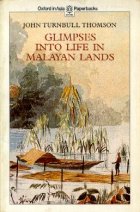 From John Turnbull Thomson's 'Glimpses Into Life in Malayan
Lands' From John Turnbull Thomson's 'Glimpses Into Life in Malayan
Lands'
John Turnbull Thomson was a young surveyor when he first
arrived in the Malay Peninsula in 1838. Only 17 years of age, he
started work in Penang and arrived in time to witness first-hand the
events surrounding Kedah's last war of independence from Siam. He took
an interest in the Malays and soon learned to speak Malay fluently,
quickly gaining a reputation as having closer contact with the Malays
than any of his fellow countrymen. He frequently wrote of the
grievances of the Malays and his description of the Kedah war below
highlighted not only the miseries suffered by ordinary Malays at the
hands of the Siamese army but also the unease of many Englishmen at
Britain's support for Siam in the conflict.
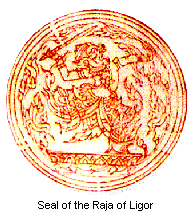 Kedah
was a weak Eastern state, situated at the fag end of two powerful ones,
viz., the Siamese and Burmese. It was expected to serve both these
masters ; consequently it hated one and despised the other, and got
into bad odour with both. When Burmah was stronger than. Siam, it
acknowlegded its superiority; when Siam was stronger, it paid obeisance
in that direction. The exactions, whether of men, money, tokens or
symbols, that Kedah had to bear, were at the caprice of the monarchs of
these countries. Kedah would have gladly propitiated either for the
sake of peace ; but this was not to be. Siam claimed a token - the
Bunga Mas (golden flower) -while Burmah claimed assistance in men. What
was to be done? The English were powerful; -might not Kedah rest quiet
under her wings ? Kedah
was a weak Eastern state, situated at the fag end of two powerful ones,
viz., the Siamese and Burmese. It was expected to serve both these
masters ; consequently it hated one and despised the other, and got
into bad odour with both. When Burmah was stronger than. Siam, it
acknowlegded its superiority; when Siam was stronger, it paid obeisance
in that direction. The exactions, whether of men, money, tokens or
symbols, that Kedah had to bear, were at the caprice of the monarchs of
these countries. Kedah would have gladly propitiated either for the
sake of peace ; but this was not to be. Siam claimed a token - the
Bunga Mas (golden flower) -while Burmah claimed assistance in men. What
was to be done? The English were powerful; -might not Kedah rest quiet
under her wings ?
 Such
might have been the thought when Kedah offered Penang to Captain Light.
Captain Light, on behalf of' the East India Company, bought the island
for a consideration; but he did not engage to protect Kedah from its
political enemies - the real of object of the Malay Rajah. Such
might have been the thought when Kedah offered Penang to Captain Light.
Captain Light, on behalf of' the East India Company, bought the island
for a consideration; but he did not engage to protect Kedah from its
political enemies - the real of object of the Malay Rajah.
Captain Light took possession of the purchased island of
Penang, on the l7th July, 1786. If it belonged to Siam, Siam should
have protested against the transfer. This Siam did not do. Sir George
Leith again, on behalf of the East India Company, bought Province
Wellesley from Kedah for the sum of two thousand Spanish dollars. This
happened on the 15th July, 18OO, nor was this transfer opposed by
action or protest on the part of Siam. If Kedah had been a province of
Siam, and the Rajah of' Kedah a mere vassal, these cessions of
territory at distinct dates must have either been silently approved of
by Slam, if not, those were the times to protest.
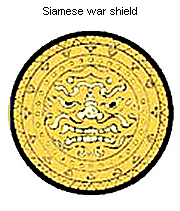 Kedah
sent admissions of superiority to Siam, but so does Siam to China.
Reasoning on the basis of these admissions, how is it that, in after
years, Siam claimed more to do with Penang than did China? Kedah had
her native line of princes, son succeeding father for generations, as
Siam has nephew succeeding uncle. Kedah had her written laws as Siam
has. What difference was there between these two kingdoms ? -Merely
this, Siam was strong, Kedah weak. The claims of Siam were the claims
of might, not of right. Siam was jealous that Kedah had obtained an
European friend and neighbour, so she determined to vex her. First she
coerced Kedah to make war on Perak : this was in 1813. The object was
to weaken both, preparatory to their being overrun. In 1821 Siam
overran Kedah, and its native princes fled. She would have done the
same to Perak, but for the fear of the English and the Dutch. Kedah was
devastated, and many of her inhabitants carried off to slavery.
Thousands fled into Penang and Province Wellesley. This suited the
purposes of the English land proprietors ; it cleared their jungles,
and gave them a settled population. In 1822 the Burmese war was looming
in the distance; so it was found to be English policy to propitiate
Siam. Kedah relations were consequently sacrificed, and the grant of
Penang and Province Wellesley was sought to be confirmed by Siam. This
object was attained in 1826, under Colonel Burney's treaty with Siam. Kedah
sent admissions of superiority to Siam, but so does Siam to China.
Reasoning on the basis of these admissions, how is it that, in after
years, Siam claimed more to do with Penang than did China? Kedah had
her native line of princes, son succeeding father for generations, as
Siam has nephew succeeding uncle. Kedah had her written laws as Siam
has. What difference was there between these two kingdoms ? -Merely
this, Siam was strong, Kedah weak. The claims of Siam were the claims
of might, not of right. Siam was jealous that Kedah had obtained an
European friend and neighbour, so she determined to vex her. First she
coerced Kedah to make war on Perak : this was in 1813. The object was
to weaken both, preparatory to their being overrun. In 1821 Siam
overran Kedah, and its native princes fled. She would have done the
same to Perak, but for the fear of the English and the Dutch. Kedah was
devastated, and many of her inhabitants carried off to slavery.
Thousands fled into Penang and Province Wellesley. This suited the
purposes of the English land proprietors ; it cleared their jungles,
and gave them a settled population. In 1822 the Burmese war was looming
in the distance; so it was found to be English policy to propitiate
Siam. Kedah relations were consequently sacrificed, and the grant of
Penang and Province Wellesley was sought to be confirmed by Siam. This
object was attained in 1826, under Colonel Burney's treaty with Siam.
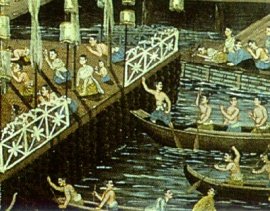 In
1831 Tuanku Kudin, a chief of Malay royal blood, headed an insurrection
against his Siarnese conquerors. He was successful at first, and
regained temporary possession of his native country. But England's
assistance was now given to Siam, and he was reduced. He remained by a
remnant of his adherents, fifty or sixty in number, and died a hero's
death in defending Kedah fort. He was overpowered by numbers, and
nearly all died with him. As in the case of Sir William Wallace, the
patriot's head was sent to the (Siamese) capital. Kedah was again
devastated, and Province Wellesley replenished with settlers; lands
rose in value, and rents ruled high. It was at this time that the East
India Company's chief official took up extensive land claims. In
1831 Tuanku Kudin, a chief of Malay royal blood, headed an insurrection
against his Siarnese conquerors. He was successful at first, and
regained temporary possession of his native country. But England's
assistance was now given to Siam, and he was reduced. He remained by a
remnant of his adherents, fifty or sixty in number, and died a hero's
death in defending Kedah fort. He was overpowered by numbers, and
nearly all died with him. As in the case of Sir William Wallace, the
patriot's head was sent to the (Siamese) capital. Kedah was again
devastated, and Province Wellesley replenished with settlers; lands
rose in value, and rents ruled high. It was at this time that the East
India Company's chief official took up extensive land claims.
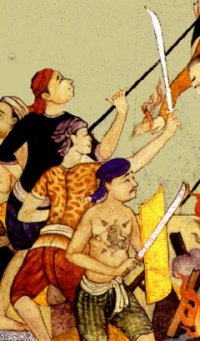 But
the value of his land acquisitions met another check ; for, in 1838, a
man called Tuanku Mohamed Saad, a prince of royal blood, raised another
insurrection against the Siamese, and carried many people away with him
from Penang and Province Wellesley. Rents fell, and the value of land
in the English settlements again became nominal. Tuanku Mahomed Saad
drove the Siamese out of Kedah beyond Sangora; but the English and the
Siamese were now allies. He was consequently beaten back, escaping only
to be laid hold of by the East India Company 's Government as a pirate,
and to be dealt with as such. But
the value of his land acquisitions met another check ; for, in 1838, a
man called Tuanku Mohamed Saad, a prince of royal blood, raised another
insurrection against the Siamese, and carried many people away with him
from Penang and Province Wellesley. Rents fell, and the value of land
in the English settlements again became nominal. Tuanku Mahomed Saad
drove the Siamese out of Kedah beyond Sangora; but the English and the
Siamese were now allies. He was consequently beaten back, escaping only
to be laid hold of by the East India Company 's Government as a pirate,
and to be dealt with as such.
Kedah this time was utterly destroyed; its fertile plains
wasted ; the herds were driven off the fields, and the fruit groves
were cut down ; the mother fled with the infant at her breast, and the
father crept through the jungle with his little ones in his arms.
Province Wellesley was again replenished with settlers, and Englishmen
speculated and grew rich on the troubles of their neighbours. More eyes
than mine have witnessed these scenes, so I dare not exaggerate. In
1786 the English settled down on a desert island near flourishing
Kedah. In I838 Kedah is itself a desert, the island Penang a very
garden full of life and prosperity. I have seen the poor Kedahan come
to the sheds and outhouses to lie down and die. Others more fortunate
in preserving life, were glad to labour for their bare rice only. The
actual strife of warfare is not the worst.
 Oamut
used frequently to exclaim, "Kalau raja berkelahi, orang kecil binasa"
("When princes fall out, the destruction comes on the lowly"). An
appropriate illustration for the tirnes. And shall we ascribe all these
miseries to the English ? Certainly not. They must lie in the first
place at the door of the Raja of Kedah, who sold Penang for a good
price. He did not fully explain his connection with Siam ; and, by this
want of frankness, brought his country into great danger. Had he not
counted on the assistance of the English (which he had no right to
expect) hr would have been more complacent to Slam, and averted her
vengeance. Kedah would have done as she did heretofore, and submitted
to exactions for the sake of peace. Oamut
used frequently to exclaim, "Kalau raja berkelahi, orang kecil binasa"
("When princes fall out, the destruction comes on the lowly"). An
appropriate illustration for the tirnes. And shall we ascribe all these
miseries to the English ? Certainly not. They must lie in the first
place at the door of the Raja of Kedah, who sold Penang for a good
price. He did not fully explain his connection with Siam ; and, by this
want of frankness, brought his country into great danger. Had he not
counted on the assistance of the English (which he had no right to
expect) hr would have been more complacent to Slam, and averted her
vengeance. Kedah would have done as she did heretofore, and submitted
to exactions for the sake of peace.
But the after part that England played in assisting Siam
against Kedah, was abhorrent to generosity, not to speak of gratitude.
Such a course would never have been sanctioned by the home authorities,
however expedient or proper it might have appeared to the East India
Company's Government in India, if they had been fully aware of the
facts of the case.
Source:
Thomson, John Turnbull, "Glimpses Into Malayan Lands",
Oxford University Press 1984 (first published by Richardson and
Company, 1864). RM 22.00
Write to the WebMaster: sabrizain@malaya.org.uk
The
Sejarah Melayu
website is
maintained solely by myself and does not receive any funding
support from any governmental, academic, corporate or other
organizations. If you have found the Sejarah Melayu website useful, any
financial contribution you can make, no matter how small, will be
deeply appreciated and assist greatly in the continued maintenance of
this site.
|
|


 From John Turnbull Thomson's 'Glimpses Into Life in Malayan
Lands'
From John Turnbull Thomson's 'Glimpses Into Life in Malayan
Lands'